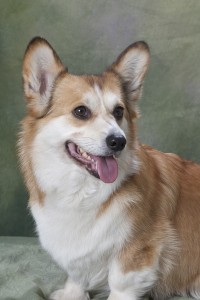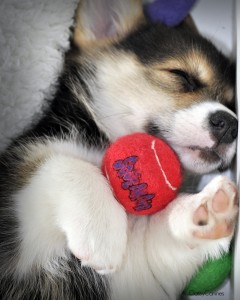About PWCs
History
The Pembroke Welsh Corgi is an ancient breed of dog. Direct ancestors of the modern Corgi were brought into Wales by Flemish weavers around 1107 A.D. These early dogs bore a remarkable resemblance to the old Schipperkes.
The Corgi is thought to descend from the same family of dogs which includes the Keeshond, Pomeranian, Samoyed, Chow Chow, Norwegian Elkhound and Finnish Spitz.
Within the past 100 years there was an effort to link or blend the Pembroke Welsh Corgi with the Cardigan Welsh Corgi. In the 1930’s both styles of Corgis were recognized as two separate breeds and not one breed of dog with two varieties.
The Breed
(From the AKC Breed Standard)
“Pembroke Welsh Corgis are to appear lowset, Sturdily built and active, giving and impression of substance and stamina in a small space. Should not be so low and heavily boned as to appear coarse or overdone, nor so light-boned as to appear racy. Outlook bold, but kindly. Expression intelligent and interested. Never shy or vicious.”
Corgis stand about 10 inches at the shoulder and should not exceed 30 pounds for males of 28 pounds for females. Corgis have a short, thick weather resistant undercoat with a coarser, longer outer coat. The outer coat colors fall into the categories of red,sable, fawn, and black and tan, with or without white markings. Corgis are “wash and wear” and a healthy coat can be maintained by an occasional bath and regular brushing to remove dead undercoat.
A Dog For All Reasons
A versatile and adaptable personality enables Corgis to adjust to almost any lifestyle, be it herding livestock or living in a city apartment. Originally bred as cattle and “driving dogs” for farm work, Corgis were also used as “varmint killers” and as ratters have no equal. (This trait may have been the reason that Corgis were first shown from the terrier group when recognized by the AKC.) Corgis excel as bird dogs, protectors, guardians and trackers. They are finding recognition as service and therapy dogs, being used successfully in hearing ear and assistance programs. This tough little breed approaches new skills with enthusiasm and thrives on formalized training. Corgis compete successfully in obedience,
tracking, agility, and herding. Simply put, Corgis just “go with the program”.
Corgis are a social and active breed. They eagerly play rough and tumble games with children, watch over a newborn. or simply a loyal companion for the elderly. As long as a Corgi knows what is expected he will readily oblige. However, if left to their own devices for long periods of time they inevitably get into mischief. Corgis are happiest when they have tasks to perform, such as bringing in the newspaper or retrieving objects dropped on the floor. The most common error first-time Corgi owners make is to underestimate their puppy and treat it as a toy breed. Make no mistake. The Corgi is a “big dog in a small body” and will become “bossy” if not trained with a FIRM but gentle hand. A Corgis I.Q. is equivalent to that of a 5 year old child and as with any 5 year old, they will test authority. Once you have reinforced your position as the head of the house, the Corgi will happily go about his business and entertain you with his antics and droll sense of humor.
Genetic Problems
Genetic problems involving hips, eyes, and temperament have been kept to a minimum through selective breeding practices by responsible breeders. Older Corgis may be prone to urinary tract problems which can usually be relieved with antibiotics and urine deacidifiers. Disc problems are not common in the Corgi although long backed dogs may be more susceptible to back injury. Any type of jumping should be supervised. “Investigate before you invest.” Buy from a responsible breeder to insure your Corgi is healthy both in body and mind.

